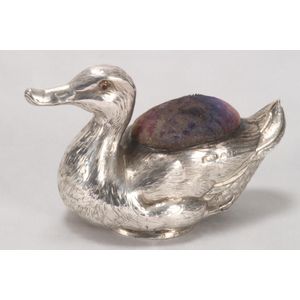Large Edwardian Sterling Silver Duck Pin Cushion
Fine Edwardian sterling silver pin cushion, hallmarked Birmingham, 1906, S&Co (Sydney & Co), of unusual large size, in the form of a swimming duck with upswept webbed feet and realistic textured plumage, with registered design number to side, total weight 74.3gm, height 6 x 10 cm length
You must be a subscriber, and be logged in to view price and dealer details.
Subscribe Now to view actual auction price for this item
When you subscribe, you have the option of setting the currency in which to display prices to $Au, $US, $NZ or Stg.
This item has been sold, and the description, image and price are for reference purposes only.
- Registered Design - During the period 1842-1883 the Patent Office issued a diamond mark along with the registration number when a design was registered.
Besides indicating that the design had been registered, a diamond mark offered the buyer the reassurance of knowing an item was of British design. It assured the person registering the design a degree of protection from copying.
The mark was created to identify the type of material used (known as the class), how many items were included, (sometimes known as bundles or packages), and the date of registration.
On the diamond mark the year of registration is shown along with the month code. However, there are two ranges of year codes; 1842-1867 and 1868-1883. By looking at the design of the diamond mark you should be able to determine the correct year from the design of the diamond mark and the placing of the day number.
Source and further information: http://www.nationalarchives.gov.uk/records/research-guides/reg-design-diamond.htm - Sterling Silver - Sterling silver is a mixture of 92.5% pure silver and 7.5% of another metal, usually copper. Fine silver is 99.9% pure silver, and is relatively soft and the addition of the very small amount of copper gives the metal enough strength and hardness to be worked into jewellery, decorative and household objects.
- Edwardian - The Edwardian period of English furniture and decorative arts design is named for Edward VII (1841 ? 1910) who was King of the United Kingdom and the British Dominions and Emperor of India for the brief period from 1901 until his death in 1910. It follows the Victorian period, in turn was followed by the Art Nouveau and Art Deco styles. In Australia, designs of this period are also known as being in the Federation style.
This item has been included into following indexes:
-
sewing, implements and accessories
- other 452
- pin cushions 296
- threads 452
